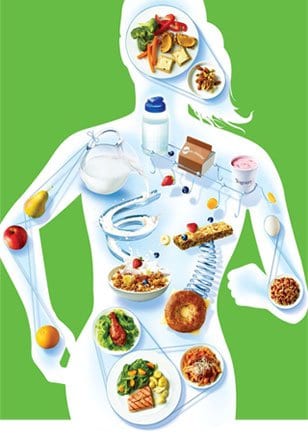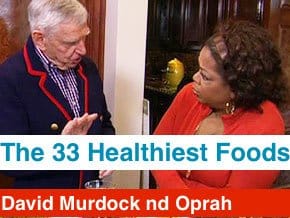Three Nutrition and Exercise Tips for Your Long and Strong Life
Food and exercise is medicine, particularly the right types of food and medicine. Read about the scientific-based nutrition and exercise tips to activate cellular health and keep you young.
 OVER THE last couple of weeks, I’ve bumped into a few articles on the Interwebs (and one demystifying infographic) about nutrition and exercise tips that speak to increasing longevity, and more importantly, health span — the number of years you’re healthy as opposed to barely alive.
OVER THE last couple of weeks, I’ve bumped into a few articles on the Interwebs (and one demystifying infographic) about nutrition and exercise tips that speak to increasing longevity, and more importantly, health span — the number of years you’re healthy as opposed to barely alive.
Rather than summarize each for your edification, I’ve cobbled them together to present one fine, if bumpy, road that you may choose to travel in order to build a long and strong life for yourself.
I refer to it as a “bumpy” road, because, inevitably, we will stumble a bit when trying to make a habit of something new. The road to reach a substantially longer healthspan must be built with many different cobblestones, sorta speak, and some are large enough for you to trip over from time to time.
But that doesn’t mean that the journey’s not worth taking!
Some people will trip on the required exercise, others on the nutritional necessities, and still others will stumble on developing the proper mindset.
My longevity process incorporates 12 building blocks that make up four Pillars, which I introduced in “The Ageproof Method” blog post, and which is the subject of my forthcoming book. It would be natural and expected that anyone trying to embrace all 12 of these “building blocks” would trip up from time to time.
So what!?
You start with what is your lowest hanging fruit, and then gradually climb the tree.
OK, before you’re completely exhausted paving your road with cobblestones, constructing pillars with building blocks and climbing trees, let’s get into what’s right here for you to explore.
In this article, we’ll cover some nutrition and exercise tips that speak to:
- Foods that activate a special protein that helps keep your cells healthy and youthful
- A simple way of judging how much of each food type you should eat for your size
- Which types of exercises are best to extend your healthspan
- A crazy but amazingly effective technique to get the right mindset to do it all
Let’s dive in…
#1 Eat Foods That Boost Nrf2
Nrf2 is a special type of protein that plays an important role in cellular health. It does that by regulating the expression of antioxidant proteins that protect against oxidative damage triggered by injury and inflammation. (1)
Researchers working at the University of Warwick in England discovered that Nrf2, continually moves in and out of a human cell’s nuclei to sense their health and vitality. When exposed to threats to the cellular health, Nrf2 oscillates faster and activates an increase in the cell’s defense mechanism, including raising antioxidant levels.
Professor Paul Thornalley at the University of Warwick Medical School says that by understanding how this Nrf2 process works, healthier foods and improved drugs can be devised. (2) 
But you don’t have to wait for that, because there are two foods you can chow down right now that activate Nrf2:
- Broccoli, and
- Onions.
The Warwick researches observed that sulforaphane in broccoli, and quercetin in onions, are capable of increasing Nrf2 movement. Typically the Nrf2 protein oscillates in and out of the cell nucleus once every 129 minutes, but when the team found that sulforaphane and quercetin were consumed, the cycle sped up to once every 80 minutes. (3)
The simple reason you should care about your Nrf2 activity speaks to the Free Radical Theory of Aging which states that organisms (like us) age because cells accumulate free radical damage over time. What scientists are now discovering is that Nrf2 activity (oscillation) can be augmented by certain foods and supplements and thereby become a more effective free radical scavenger.
I was surprised that the Warwick study didn’t go further and identify other foods containing sulfoaphane and quercetin that speed up Nrf2 oscillation, for many other foods contain these two compounds. In fact, I bet that many of billionaire David Murdock declared to be the 33 healthiest foods on the planet contain much sulforaphance and quercetin. 
Murdock funded the research and the apparatus that identified the 33 health foods; namely, a two-story, 950-megahertz, 8-ton superconducting magnet. It is reputedly the largest and most powerful magnet in the world and facilitates the examination of both plant and human cells at the most minute level.
I learned about David Murdock via an Oprah Winfrey interview, and wrote about it in, 86 Year-old Billionaire’s Recipe for Longevity. The list of 33 foods is listed in that article.
If you already know that you won’t eat broccoli or onions with any regularity (or want to super boost your consumption of them), you may consider supplementing for sulforaphane and quercetin.
Two such supplements I mention in How Not To Die, Part 1 are Solgar’s Quercetin Complex and Source Naturals’ Broccoli Sprout Extract.
Now that you know about what to eat to boost Nrft2 activation and thereby quash free radical damage, let’s spend a few minutes thinking about how much food (as in how many calories) you should eat.
#2 Eat From Your Palm
Enter #2 on our list of three nutrition and exercise tips for your long and strong life, which is the informative and easy-to-comprehend calorie control guide created by Precision Nutrition, a science/experiential driven nutrition consultancy.
They made the following infographic:

A few things to note about the infographic contents:
- Palm size turns out to be a good measure for estimating food consumption, as it closely correlates with a person’s overall size. Since size tends to determine caloric requirement, apportioning food quantities based on palm size should, on average, be a good indicator for consumption levels.
- Macronutrients are protein, carbs and fats, and they’re not all equal; meaning, some are better for you than others. If you eat animals, balance your protein between different kinds. Choose meat and poultry that are grass/range fed, and aren’t fed hormones and antibiotics. Try to include vegetable-sourced proteins, such as from beans and legumes. (Chickpeas and lentils are good sources.). Carbs should mostly be from vegetables and whole fruits (not fruit juices), and should be “complex carbs”; meaning that they’re slowly absorbed into the blood stream and thereby does not require the pancreas to overwork by constantly making a bunch of insulin to move the carb sugars into the bloodstream to make energy. Get more fats from omega-3 sources such as hemp seeds, flax seeds, chia seeds and fish oil.
- Active means Active and so don’t fool yourself by thinking your daily walk to the bus stop means your active enough to require extra calories, especially if you’re carrying extra pounds of body weight.
(Read Precision Nutrition’s explanation of the infographic guide here.)
#3 Move Your Body (A Lot)
Now that you’re getting dialed into what and how much of foods to eat to sustain a youthful body, let’s discuss moving it.
Yes, to live a long and strong life, you’ll have to move your body, ideally under stress, which it’s well equipped to do. Most every body comes with legs and arms, and they exist for a reason. The purpose of the legs is not to fold over a chair, and the purpose of the arms is not to curl food to your mouth.
Now, when I say “stress”, it’s not a reference to the stress that makes you an emotional mess as your cortisol rages and messes with your health. In this context, stress refers to load. The “load” is something that makes you work as you move, and thereby puts a good kinda stress on your muscular skeletal system.
For many people, walking a mile up a steep hill is sufficient load to stress their muscular, aerobic and anaerobic systems to cause a response that makes these systems stronger.
According to a review of research on senior athletes by the Journal of the American Academy of Orthopedic Surgeons (JAAOS), physical activity significantly improves musculoskeletal and overall health, and minimizes or delays the effects of aging, particularly in regard to lessening bone and joint health decline. (4)
These were the JAAOS findings by category studied:
Resistance Training
- Prolonged, intense resistance training can increase muscle strength, lean muscle and bone mass more consistently than aerobic exercise alone.
- Moderately intense resistance regimens also decrease fat mass.
- Sustained lower and upper body resistance training bolsters bone density and reduces the risk of strains, sprains and acute fractures.
Read:
Get Biologically Younger With A Fast HIIT Feast-Famine Program
The Minimum Exercise That Adds Years To Your Life
The Many Benefits of Strength Training… Even for You, Greybeard
Endurance training
- Sustained and at least moderately intensive aerobic training promotes heart health, increases oxygen consumption, and has been linked to other musculoskeletal benefits, including less accumulation of fat mass, maintenance of muscle strength and cartilage volumes.
- A minimum of 150 to 300 minutes a week of endurance training, in 10 to 30 minute episodes is recommended.
- Less vigorous and/or short-duration aerobic regimens may provide limited benefit.
Read:
An Aerobic Hike Up Mt. Rainier
Burn Your Fat With Metabolic Circuits
8 Ways To Trim Body Fat and Keep It Off Forever
Flexibility and balance
- Flexibility exercises are required for active adults to maintain range of motion, optimize performance and limit injury.
- Two days per week or more of flexibility training are recommended, such as sustained stretches and static/non-ballistic (non-resistant) movements.
- Progressively difficult postures are recommended for improving and maintaining balance.
Read:
The Functionally Fit Workout – Warm up and Mobility
OK, that wraps it for your three nutrition and exercise tips for a long and strong life, but there’s more. I have one more Tip to share that will help you enormously. Let’s call it a “Bonus Tip” for those of you who made it this far.
Bonus Tip #4: Brain Synchronization
Brain synchronization happens when the various parts of your brain begin to resonate at the same frequencies, causing neural pathways to fire more rapidly. This is also sometimes referred to as “whole brain functioning” or “hemispheric synchronization”. 
When synchronized, the left and right sides of your brain begin to work in concert. The brain’s electrical activity and energy patterns become more widespread throughout the brain instead of remaining confined to certain areas. When this happens, your brain reaches extraordinary levels of performance not normally attainable without years of practice. (5)
Anything you attempt to do that’s extraordinary requires the development of the proper mindset, which is one of my Pillars for longevity. Certainly, if your aim is to extend your lifespan and be healthy in the process, it will require reorienting your attitudes about aging.
You will need to cultivate a different mindset than you may now have.
Developing a mindfulness/meditation practice that, in part, incorporates brain synchronization can propel you by leaps and bounds toward getting the mindset that you’ll need.
You could spend a lot of time disciplining yourself to mediate like a monk, or you could get a boost by listening to Binaural Beats and Isochronic Tones while doing your mindfulness/mediation training.
This is a big topic, which I’ve covered elsewhere on this site, but suffice to say that you can soon achieve brain synchronization by putting on some stereo headphones and listening to sounds and tones that help you produce specific brainwaves associated with different levels of consciousness.
I cover what you need to know, and how to get started in two articles:
Mediate Like A Monk In 20 Minutes, and
How You Can Control Your Brainwave Frequencies, The Keys To Happiness
Prepare to get blissed out.
Your Takeaway
Let’s summarize the nutrition and exercise tips covered here, one point per Tip:
- Eat foods that activate Nrf2, which at minimum include broccoli and onions, as well as many listed here, and the supplements above mentioned. Begin by choosing three foods, and then add another each week.
- Measure the amount of food that you eat from the three macronutrients – protein, carbs and fats – by the size of your palm, as the infographic explains.
- Move your body regularly by doing strength training, aerobics and mobility exercises. A body that does not move, or moves little, deteriorates. It’s that simple.
- Develop the right mindset for whatever you want to achieve in life by cultivating a mindfulness/mediation practice. Brain synchronization techniques can help enormously. Do yourself a favor and check out the links I listed above.
P.S. If you still have anything left in the tank, check out Life Extension Foundation’s article, Halt Age-Related Muscle Loss.
Last Updated on April 11, 2023 by Joe Garma





